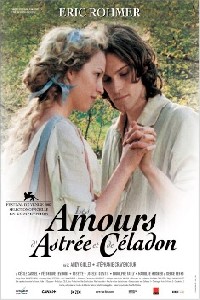
LES AMOURS DE ASTREE ET CELIDON (THE ROMANCE OF ASTREA AND CELADON)
France, 2007, 109 minutes, Colour.
Andy Gillet, Stephanie Crayencour, Cecile Cassel, Veronique Reymond.
Directed by Eric Rohmer.
The Romance of Astrea and Celadon is a film that could be made only my Eric Rohmer or one of his disciples. It is based on a 17th century novel by Henry D’ Urfe. In turn, it is a novel about the times in Gaul in the 5th century at the time of the collapse of the Roman Empire and the establishment of the Gauls- especially in the French countryside. However, Rohmer has chosen to film it in 17th century style while keeping the plot in the 5th century.
Rohmer is a man who has made moral fables for 50 years or more. In the 1960s with such films as My Night at Maud’s and Claire’s Knee, he established himself as a perfectionist in artistic and morally restrained films. It was the implicit values, the delicate presentation of character and interactions, which charmed audiences as well as critics. As the decades went on, he chose to do a range of moral stories and fables including Pauline at the Beach, The Fine Marriage, as well as historical films like The Marquise of O and Percival the Gaul.
Even at the beginning of the 20th century, he made a costume drama, The Lady and the Duke as well as a more contemporary piece, The Triple Agent.
This film is beautiful to look at - it is almost a museum piece, full of tableaux of shepherds and shepherdesses in the French countryside (near the Loire river and its shadows), in woods, in castles. The dialogue is very much of its era - which also makes the film something of a museum piece.
There are echoes of the 17th century writings of Shakespeare and his lyrical and pastoral plays. Realism is not to the fore though much of the action takes place naturalistically. However, there is a tension between the realism and the artificiality of the dialogue and many of the set speeches (a feature of Rohmer films).
The film is the basic one about love, deception, the hardness of heart of the woman and the despair of the man, intervention by special characters who are able to heal the wounds and bring the couple together again. This is done with the background of Nature Religion and the Druids - but with speeches, especially about the three facets of the gods, which incorporates aspects of Christian Trinitarian Theology.
Not to the taste of contemporary audiences - more an illustration of the style of filmmaking that Rohmer specialised in and a view of a more French literary tradition.
1.The many decades of Eric Rohmer’s work? Visually beautiful? Literary? The importance of language, dialogue? Romance? Moral fables?
2.The origins of this film in a 17th century tale, the decision to make the story visual as of the 17th century? The original setting of the story in the 5th century? The verbal references to the Gauls and the Romans? Suitable for this 17th century style?
3.Costumes, pastoral? The locations, the river, the village, the forest? The castle? Interiors? The look of the film – in terms of painting? Tableaux?
4.The title, the romantic nature of the story, the characters? Misunderstandings, fidelity, love?
5.The focus on Astrea, the shepherdess, her friend telling her about Celadon? Her going to the fair, seeing Celadon dance with the girl? Her having commanded him to deceive his parents and flirt with the girl? The banquet? Celadon and the girl kissing him behind the tree? Astrea, her reaction, her jealousy?
6.Celadon, the shepherd, his family background, his working for his living? Going into the fields, calling Astrea, her refusal to speak? Her accusations, her bitterness? His inability to defend himself? Her banishing him? Forbidding him to come unless she called him?
7.Celadon, despair, throwing himself into the river, going downstream, on the sand? Rescued by the nymphs? Being taken to the castle? Their knowing his identity? The Druid uncle and the prophecies? Galathea and her attraction to Celadon? Leonida and her taking care of him? The food, the clothing? Her helping him to escape?
8.Galathea, the nymphs, the prophecies of the Druids? Their taking Celadon to the castle? Galathea and her being excluded because of his love for Astrea?
9.The palace, the Druid uncle, his hold over the household? His helping Celadon? Reliance on Leonida? Sylvie and her care for Celadon?
10.The Druid religion, the nature religion? The names of the gods? The long discussion between the Druid and Celadon in the forest, the Roman statues, aspects of the god? The long theological discussion about the three aspects of God in the one God? The mixing of Catholic theology with Druid mysticism?
11.Astrea, her grief? Phillis and Lycidas and their condemnation of Astrea? Her acknowledging the truth, her hardness? Going with the group to celebrate the Mistletoe Feast?
12.Celadon in the forest, the uncle helping him to build the tent? His staying there? His dreams of Astrea?
13.His seeing Astrea in the forest? Going back to the castle? The decision to disguise him as a woman? The group coming to the castle? Leonida and her help? Phillis and her help?
14.The credibility of Celadon’s disguise as the daughter? Veiled? The others and their looser dress? The attraction towards Astrea, her attraction towards Alexia? The sexual overtones – or not?
15.The build-up to the night, the separate beds? Astrea and her breast? The effect on Celadon? The morning, the talk, the preparation for the day?
16.The celebration, the rituals, Druid nature religion? The mistletoe? Astrea and her change of heart, her recognition of Celadon? The prospects for a happy ending?
17.The film as old-style film-making? Classic? With the touch of the museum piece? The statues and tableaux? The 17th century pastoral stories like those in Shakespeare? For a 21st century audience?